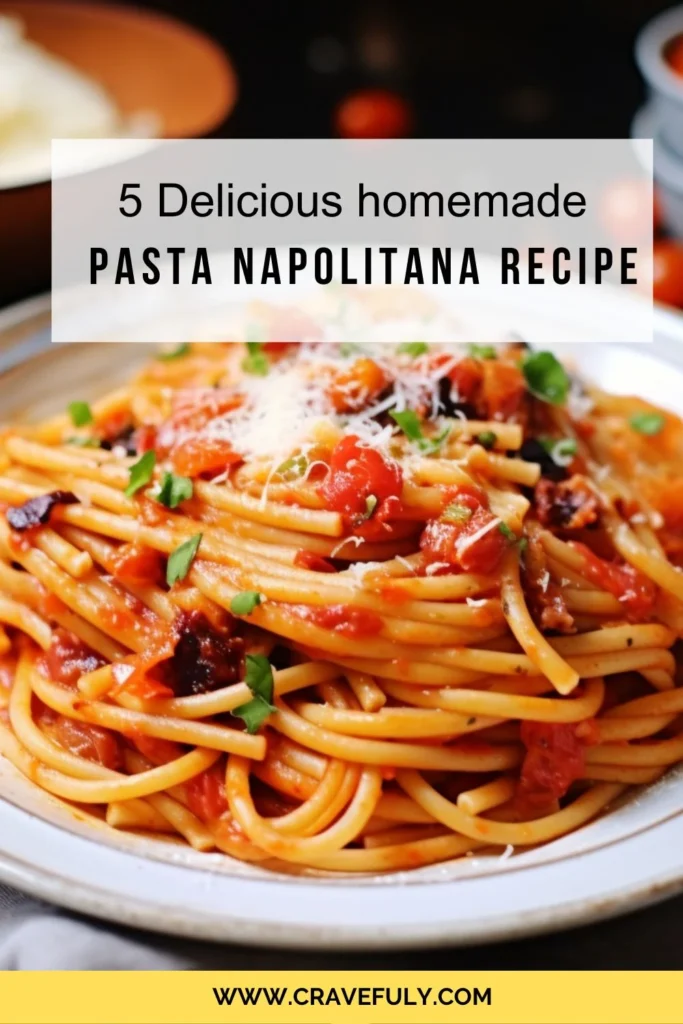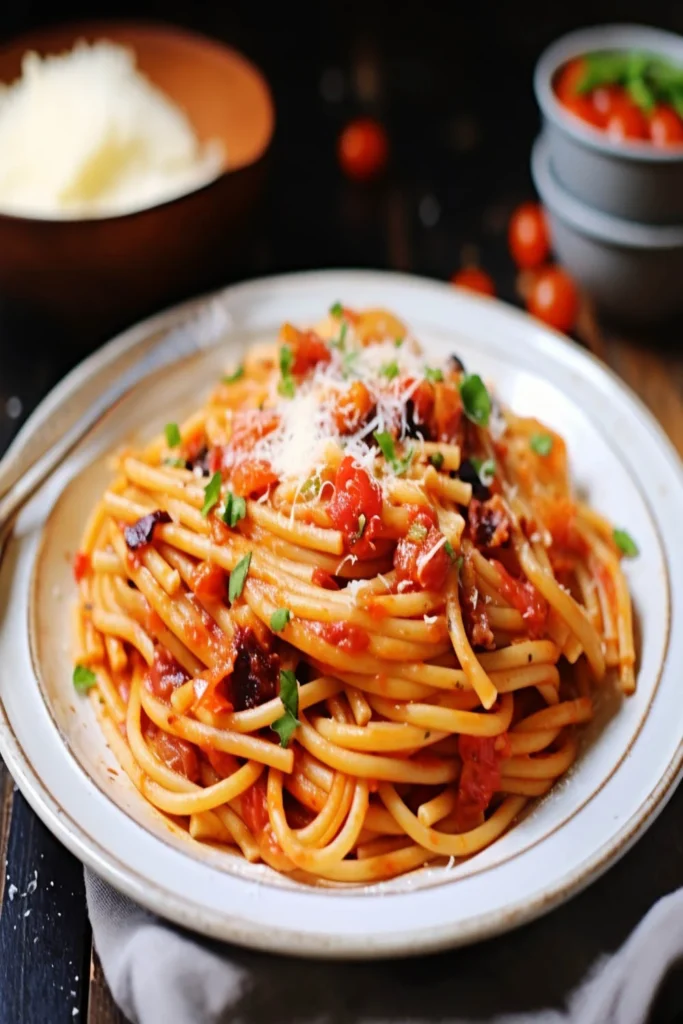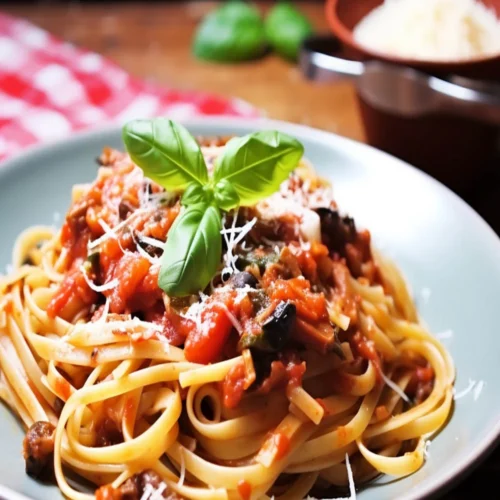If you’re a fan of Italian cuisine, you’ve probably heard of Pasta Napolitana. This timeless dish is beloved for its simplicity and rich flavors. In this blog post, we will provide you with a recipe for Pasta Napolitana that is sure to become a favorite in your household.
From the ingredients you’ll need to make this dish to the step-by-step instructions, we’ve got you covered. Additionally, we’ll discuss the reasons why this recipe works so well and provide you with some useful tips to ensure your dish turns out perfectly. So let’s get started!

What is Pasta Napolitana?
Neapolitan sauce, also known as Napoli sauce or Napoletana sauce, refers to a collective name for various tomato-based sauces derived from Italian cuisine. It is a simple yet incredibly flavorful recipe that features a delicious tomato sauce served over pasta.
The sauce is made with onion, garlic, vine-ripened tomatoes, olive oil, basil, salt, and pepper. It is then topped with a generous sprinkle of aged Parmesan cheese. The combination of these ingredients creates a harmonious blend of flavors that is both comforting and satisfying.
Why This Recipe Works:
1. The choice of bucatini pasta: Bucatini is a type of pasta that resembles thick spaghetti but with a hollow center. Its unique shape allows it to hold the sauce effectively, resulting in a more flavorful bite.
2. The quality of ingredients: Using high-quality ingredients such as vine-ripened tomatoes, fresh basil, and aged Parmesan cheese ensures a more authentic and delicious taste.
3. Proper seasoning: The addition of Himalayan salt and freshly ground black pepper enhances the flavors of the dish without overpowering them.
4. The cooking technique: Cooking the onion and garlic until they are fragrant and translucent gives the sauce a deep and rich flavor that elevates the overall taste of the dish.
Ingredients You’ll Need To Make This Pasta Napolitana Recipe:
Pasta:
Bucatini – A type of artisanal pasta that adds a satisfying texture to the dish. Its long, hollow shape allows the sauce to cling to it, enhancing the overall flavor.
Napoletana Sauce:
- Onion – Finely chopped onion provides a sweet and savory base to the sauce, contributing depth and complexity to the overall flavor profile.
- Garlic – Minced garlic adds aromatic intensity and a rich taste, enhancing the savory notes of the sauce.
- Tomatoes – Vine-ripened tomatoes, whether whole, diced, or cherry, form the core of the sauce. They bring a natural sweetness and acidity, creating a well-balanced and vibrant flavor.
- Olive Oil – Exquisite or extra virgin olive oil not only serves as a cooking medium but also imparts a distinctive fruity and peppery flavor to the sauce, enhancing its overall richness.
- Basil Leaves – Chopped or torn basil leaves contribute a fragrant, herbaceous quality to the sauce, complementing the sweetness of the tomatoes and adding a fresh, aromatic element.
- Black Pepper – Freshly ground black pepper provides a subtle heat and a touch of spiciness, elevating the complexity of the sauce.
- Himalayan Salt – Adding a hint of Himalayan salt enhances the flavors in the sauce, helping to balance the sweetness of the tomatoes and other ingredients.
- Parmesan – Aged Parmesan serves as a finishing touch, providing a salty and nutty flavor that ties the dish together. Its umami-rich profile adds depth and richness to the pasta.

How To Make Pasta Napolitana?
Step 1: Prepare the Ingredients
Begin by finely chopping an exceptionally large-sized onion.
Next, mince the aromatic garlic cloves to release their rich flavor.
If using whole tomatoes, dice them into smaller pieces; if opting for cherry tomatoes, leave them whole to enhance the presentation.
Chop or tear the fragrant basil leaves, ensuring they are fresh and vibrant.
Lastly, grate or prepare 6 tablespoons of aged Parmesan cheese to add a savory touch.
Step 2: Cook the Bucatini
Bring a large pot of water to a boil, adding salt to enhance the pasta’s flavor.
Cook the artisanal bucatini according to the package instructions or until it reaches the desired al dente texture.
Once cooked, drain the pasta and set it aside, ready to be combined with the flavorful sauce.
Step 3: Prepare the Napoletana Sauce
In a large pan, heat 2 tablespoons of exquisite olive oil over medium heat.
Add the finely chopped onion and sauté until it becomes translucent, releasing its sweetness.
Stir in the minced garlic, allowing it to cook for an additional 1-2 minutes until it becomes fragrant and golden.
Pour in the canned tomatoes along with their juices. If using whole tomatoes, use a spoon to break them into smaller pieces.
Season the sauce with freshly ground black pepper and 1 teaspoon of Himalayan salt for a well-balanced taste.
Allow the sauce to simmer over medium heat for about 15-20 minutes, stirring occasionally, until it thickens into a rich and flavorful consistency.
Step 4: Finish the Dish
Once the sauce has thickened to perfection, add the chopped or torn basil leaves, infusing the dish with their aromatic essence.
Taste and adjust the seasoning, adding more salt if necessary to achieve the desired balance.
Add the cooked bucatini to the sauce, tossing until each strand is thoroughly coated with the luscious Napoletana sauce.
Drizzle with additional olive oil to enhance the dish’s depth of flavor.
Step 5: Serve
Portion the Pasta Napoletana onto individual plates or a stylish serving platter.
Sprinkle each serving generously with the aged Parmesan, allowing its savory richness to complement the vibrant flavors of the dish.
For a decorative touch, optionally garnish with additional fresh basil leaves.
Serve immediately, savoring the deliciousness of your homemade Pasta Napoletana.
Tips:
1. Use ripe and flavorful tomatoes: The quality of the tomatoes used in the sauce greatly impacts the taste of the dish. Opt for vine-ripened tomatoes or cherry tomatoes for a sweeter and more vibrant flavor.
2. Cook the onions and garlic slowly: Taking the time to cook the onions and garlic until they are fragrant and translucent enhances their flavors, resulting in a more delicious sauce.
3. Don’t overcook the pasta: Cooking the pasta until it is al dente, meaning it has a slight bite to it, is essential for the perfect texture. Be sure to follow the instructions on the package to avoid overcooking.
4. Use fresh basil leaves: Fresh basil adds a wonderful aroma and freshness to the dish. Tear or chop the leaves just before adding them to the sauce to preserve their flavors.
5. Experiment with toppings: While aged Parmesan is the traditional choice for this recipe, you can also try using other cheeses such as pecorino Romano or grana padano for a different taste experience.

Nutrition Information:
The following nutrition information is approximate and may vary depending on the specific brands and quantities of ingredients used:
– Calories: 328
– Total Fat: 13g
– Saturated Fat: 4g
– Cholesterol: 12mg
– Sodium: 820mg
– Total Carbohydrate: 68g
– Dietary Fiber: 4g
– Sugars: 8g
– Protein: 16g
How to Store The Leftovers?
If you have any leftovers, you can store them in an airtight container in the refrigerator for up to 3 days. To reheat, simply place the pasta and sauce in a microwave-safe dish and heat it in the microwave until warmed through. Alternatively, you can also reheat it on the stovetop by adding a splash of water or olive oil to prevent it from drying out.
What are some recommended side dishes for Pasta Napolitana?
1. Garlic Bread: A classic accompaniment to pasta, garlic bread adds a delightful crunch and flavor to the meal. Simply slice a baguette, spread a mixture of butter and minced garlic on top, and bake until golden and crispy.
2. Caprese Salad: A refreshing salad made with ripe tomatoes, fresh mozzarella cheese, and basil leaves. Drizzle with olive oil and balsamic vinegar for a tangy touch.
3. Caesar Salad: The creamy and tangy dressing of a Caesar salad complements the rich flavors of Pasta Napolitana. Top it with croutons and shaved Parmesan cheese for an added crunch.
4. Roasted Vegetables: Roasting vegetables such as zucchini, bell peppers, and cherry tomatoes brings out their natural sweetness and adds a layer of depth to the meal.
If the items are not available in your pantry, what are some substitute options for the ingredients?
1. Pasta: If you don’t have bucatini pasta on hand, you can substitute it with spaghetti, linguine, or any other long pasta shape.
2. Tomatoes: In the absence of vine-ripened tomatoes, you can use canned crushed tomatoes or tomato sauce. However, note that the flavor and texture of the sauce may slightly differ.
3. Basil: If fresh basil is not available, you can use dried basil instead. However, use it sparingly as the flavor can be more concentrated.
4. Parmesan cheese: Parmesan cheese can be substituted with pecorino Romano or grana padano, which are similar types of hard Italian cheeses.

Pasta Napolitana Recipe
Equipment
- pot
Ingredients
Pasta:
- 16 oz about 450 grams artisanal bucatini
Napoletana Sauce:
- 1 large-sized onion finely chopped
- 4-6 aromatic garlic cloves minced
- 2 cans 14oz/400 grams each vine-ripened tomatoes (whole, diced, or cherry tomatoes)
- 2 Tbsp olive oil or extra virgin olive oil plus more for drizzling
- 2 handfuls of fragrant basil leaves chopped or torn
- ¼ tsp freshly ground black pepper
- 1 tsp Himalayan salt plus more to taste
- 6 tbsp aged Parmesan to serve
Notes
- Use ripe and flavorful tomatoes: The quality of the tomatoes used in the sauce greatly impacts the taste of the dish. Opt for vine-ripened tomatoes or cherry tomatoes for a sweeter and more vibrant flavor.
- Cook the onions and garlic slowly: Taking the time to cook the onions and garlic until they are fragrant and translucent enhances their flavors, resulting in a more delicious sauce.
- Don’t overcook the pasta: Cooking the pasta until it is al dente, meaning it has a slight bite to it, is essential for the perfect texture. Be sure to follow the instructions on the package to avoid overcooking.
- Use fresh basil leaves: Fresh basil adds a wonderful aroma and freshness to the dish. Tear or chop the leaves just before adding them to the sauce to preserve their flavors.
- Experiment with toppings: While aged Parmesan is the traditional choice for this recipe, you can also try using other cheeses such as pecorino Romano or grana padano for a different taste experience.
Frequently Asked Questions:
Q1: Can I add meat to this Pasta Napolitana recipe?
A: Absolutely! If you prefer a heartier dish, you can add cooked ground beef, Italian sausage, or shredded chicken to the sauce while it simmers. Just ensure that the meat is fully cooked and seasoned before adding it to the sauce.
Q2: Can I make the sauce in advance and store it?
A: Yes, you can prepare the sauce in advance and store it in the refrigerator for up to 3 days. This can be a time-saving option if you plan to serve the pasta later or on a busy weeknight.
Q3: Can I make this recipe vegetarian or vegan?
A: Yes, you can easily make this recipe vegetarian by omitting the meat-based ingredients and using vegetable broth or water instead. To make it vegan, use a plant-based pasta and substitute the Parmesan cheese with a vegan alternative or nutritional yeast.
Q4: Can I freeze the Pasta Napolitana?
A: While it is technically possible to freeze the Pasta Napolitana, it is not recommended as pasta tends to lose its texture and become mushy when thawed and reheated. It is best enjoyed fresh or stored in the refrigerator for a few days.
Q5: Can I adjust the spiciness of the sauce?
A: If you prefer a spicier sauce, you can add red pepper flakes or finely chopped chili peppers to the sauce while it simmers. Adjust the amount according to your taste preferences.
Conclusion:
Pasta Napolitana is a classic Italian dish that has stood the test of time for a reason. With its simple yet delicious flavors, it is a dish that can be enjoyed by people of all ages.
By following our recipe and incorporating the suggested tips and variations, you can create a Pasta Napolitana that will impress your family and friends.
So gather your ingredients, set aside some time, and get ready to savor the flavors of Italy in your own kitchen. Buon appetito!
